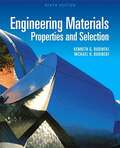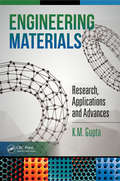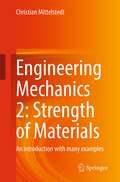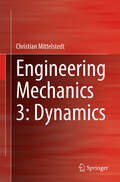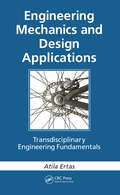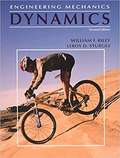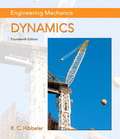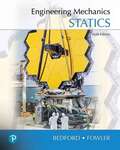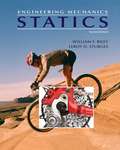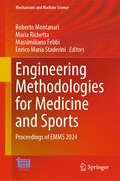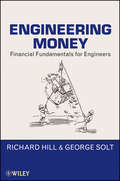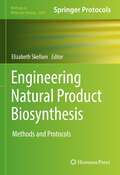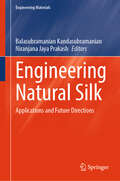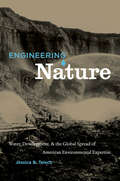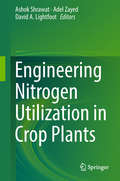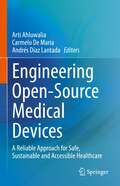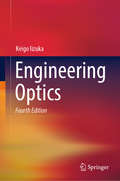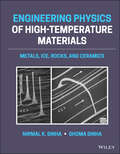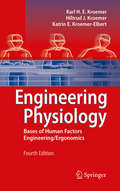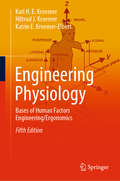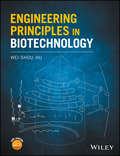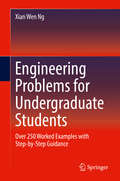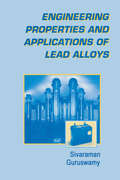- Table View
- List View
Engineering Materials: Properties And Selection
by Kenneth Budinski Michael BudinskiThe father-son authoring duo of Kenneth G. Budinski and Michael K. Budinski brings nearly 70 years of combined industry experience to bear in this practical, reader-friendly introduction to engineering materials. This text covers theory and industry-standard selection practices, providing students with the working knowledge to make an informed selection of materials for engineering applications and to correctly specify materials on drawings and purchasing documents. Encompassing all significant material systems–metals, ceramics, plastics, and composites–this text incorporates the most up-to-date information on material usage and availability, addresses the increasingly global nature of the field, and reflects the suggestions of numerous adopters of previous editions.
Engineering Materials: Research, Applications and Advances
by K.M. GuptaIntroduces Emerging Engineering MaterialsMechanical, materials, and production engineering students can greatly benefit from Engineering Materials: Research, Applications and Advances. This text focuses heavily on research, and fills a need for current information on the science, processes, and applications in the field. Beginning with a bri
Engineering Mechanics 2: An introduction with many examples
by Christian MittelstedtThis book follows the classical division of engineering mechanics as taught at universities in Germany and is devoted to strength of materials, i.e. the determination of stresses and of deformations in elastic bodies. The aim of this book is to provide students with a clear introduction and to enable them to formulate and solve engineering problems in this field. For this purpose, the book provides a number of examples. This book is intended for university students of mechanical engineering, civil engineering, mechanics, but also all other courses in which the contents of this book play a role. The ContentsIntroduction to linear elasticity – Plane stress state – Bars – Beams – Beam deflections – Shear stresses in beams – Torsion – Energy methods – Buckling of bars
Engineering Mechanics 3: Dynamics
by Christian MittelstedtThis book follows the classical division of engineering mechanics as it is taught at technical colleges and universities and is dedicated to dynamics, i.e. the consideration of movements of bodies under forces. The aim of this book is to provide students with a clear introduction to dynamics and to enable them to formulate and solve engineering problems independently. The book provides a number of examples for this purpose. This book is aimed at students at technical colleges and universities of mechanical engineering, civil engineering, mechanics and all other degree programmes in which dynamics plays a role.
Engineering Mechanics and Design Applications: Transdisciplinary Engineering Fundamentals
by Atila ErtasIn the last decade, the number of complex problems facing engineers has increased, and the technical knowledge required to address and mitigate them continues to evolve rapidly. These problems include not only the design of engineering systems with numerous components and subsystems, but also the design, redesign, and interaction of social, politic
Engineering Mechanics: Dynamics
by William F. Riley Leroy D. SturgesEngineering Mechanics: Dynamics presents the fundamentals of kinematics in a practical way with immediate real-world relevancy. Covering the physics of movement as it relates to particles and rigid bodies, this book explores the applications of Newton's laws, impulse, momentum, work and energy, vibrations, and much more. In-text conceptual examples illustrate difficult concepts, and end-of-chapter problems help students test both their theoretical and practical understanding. Call-out boxes highlight critical laws and theorems, while color diagrams and charts clarify complex concepts.
Engineering Mechanics: Dynamics
by Russell HibbelerA Proven Approach to Conceptual Understanding and Problem-solving Skills <P><P> Engineering Mechanics: Dynamics excels in providing a clear and thorough presentation of the theory and application of engineering mechanics. Engineering Mechanics empowers students to succeed by drawing upon Professor Hibbeler’s everyday classroom experience and his knowledge of how students learn. This text is shaped by the comments and suggestions of hundreds of reviewers in the teaching profession, as well as many of the author’s students. <P><P> The Fourteenth Edition includes new Preliminary Problems, which are intended to help students develop conceptual understanding and build problem-solving skills. The text features a large variety of problems from a broad range of engineering disciplines, stressing practical, realistic situations encountered in professional practice, and having varying levels of difficulty.
Engineering Mechanics: Statics
by Anthony Bedford Wallace FowlerEngineering Mechanics helps you learn what can often be a challenging subject more efficiently and effectively. It covers the basic principles of mechanics in an example-driven format that emphasizes critical thinking. Clear explanations are accompanied by engineering examples and practice problems. Compelling photorealistic art, free-body diagrams and a robust photograph program are integrated within the examples and throughout the reading to help you see the topics in action. The 6th Edition features 30% new or updated problems. New examples and topics keep pace with the state of the engineering field. As you read and explore concepts, new thought-provoking questions to consider help you better understand and relate to the material.
Engineering Mechanics: Statics
by I. C. JongThis textbook and the following volume, Engineering Mechanics: Dynamics, are designed with a goal to provide students with a clear and thorough presentation of some well-understood basic principles and their application to the analysis of any problem in engineering mechanics in a concise and logical manner. It is hoped that this text will help instructors achieve this goal in their teaching of students in the first courses in statics and dynamics, which are in most cases offered in the sophomore or junior year in engineering curricula. In the development of the text, students are assumed to have certain basic background in algebra, geometry, trigonometry, and calculus. Nevertheless, a prior course in college physics normally enables students to attain a higher degree of readiness for learning the first courses in engineering mechanics.
Engineering Mechanics: Statics
by William F. Riley Leroy D. SturgesThese exciting books use full-color, and interesting, realistic illustrations to enhance reader comprehension. Also include a large number of worked examples that provide a good balance between initial, confidence building problems and more advanced level problems. Fundamental principles for solving problems are emphasized throughout.
Engineering Methodologies for Medicine and Sports: Proceedings of EMMS 2024 (Mechanisms and Machine Science #162)
by Roberto Montanari Maria Richetta Massimiliano Febbi Enrico Maria StaderiniThis book presents the proceedings of the International Workshop on Engineering Methodologies for Medicine and Sports (EMMS), held in Rome, Italy on February 7-9, 2024. It includes peer-reviewed papers on emerging engineering methodologies applied to biomedicine and sports, discussing topics such as advanced biomaterials, biodegradable implants, additive manufacturing of prosthesis, surface design, fabrication of bioreactors, design of biomechanical devices, rehabilitation and prevention, AI applications to medicine, biosensors, medical signal analysis, medical sensors, detection and monitoring of substances dangerous for health, biomechanics, assessment of sport performance, sport activity as a diagnostic device. A valuable, up-to-date resource, it offers an essential overview of the subject for scientists and practitioners alike, and will inspire further investigations and research.
Engineering Money
by Richard Hill George SoltThere are many text books about engineering design and some include project evaluation techniques. There are text books on accounting methods and yet others on business management. This book does not aim to replace these specialized texts but brings together the elements of these subjects that young engineers working in industry - particularly the construction industry and its customers - need to understand.Most engineers learn about money the hard way: by experience in the workplace. The authors having done this themselves recognized the gap in engineers' education and set out to bridge it. This book is based on a 1996 course George Solt pioneered for final-year engineering undergraduates. The book is written in an approachable style and gives young engineers as well as mature engineers an insight into the way engineering businesses run, the importance of capital and the problems of cash flow.
Engineering Natural Product Biosynthesis: Methods and Protocols (Methods in Molecular Biology #2489)
by Elizabeth SkellamThis volume highlights natural products, molecular methods for identifying, and current trends in designing non-natural natural products. Chapters guide readers through protocols on heterologous expression techniques, gene disruption, modified pathway regulators, and in-vitro studies. Written in the format of the highly successful Methods in Molecular Biology series, each chapter includes an introduction to the topic, lists necessary materials and reagents, includes tips on troubleshooting and known pitfalls, and step-by-step, readily reproducible protocols. Authoritative and cutting-edge, Engineering Natural Product Biosynthesis: Methods and Protocols aims to be a useful and practical guide to new researchers and experts looking to expand their knowledge. Chapter 13 is available open access under a Creative Commons Attribution 4.0 International License via link.springer.com.
Engineering Natural Silk: Applications and Future Directions (Engineering Materials)
by Balasubramanian Kandasubramanian Niranjana Jaya PrakashThis book highlights the potential of silk in a vast array of applications, mainly in the field of medicine, electronics, and cosmetics. The silk proteins are generally contrived within the specialized glands of the arthropods, viz silkworms, spiders, and moths posterior to the biosynthesis occurring inside the epithelial cells. The unique conformational orientation comprising of hydrophobic crystalline beta-sheet domains and hydrophilic amorphous random coil structure, their tunability, presence of plenteous functional groups, mechanical strength, ease of regeneration, biocompatibility and biodegradability has enabled silk to grow beyond textile materials over last few decades making it an excellent alternative to synthetic polymers.
Engineering Nature: Water, Development, and the Global Spread of American Environmental Expertise
by Jessica B. TeischFocusing on globalization in the late nineteenth and early twentieth centuries, Jessica Teisch examines the processes by which American water and mining engineers who rose to prominence during and after the California Gold Rush of 1849 exported the United States' growing technical and environmental knowledge and associated social and political institutions. In the frontiers of Australia, South Africa, Hawaii, and Palestine--semiarid regions that shared a need for water to support growing populations and economies--California water engineers applied their expertise in irrigation and mining projects on behalf of foreign governments and business interests. Engineering Natureexplores how controlling the vagaries of nature abroad required more than the export of blueprints for dams, canals, or mines; it also entailed the problematic transfer of the new technology's sociopolitical context. Water engineers confronted unforeseen variables in each region as they worked to implement their visions of agrarian settlement and industrial growth, including the role of the market, government institutions, property rights, indigenous peoples, labor, and, not last, the environment. Teisch argues that by examining the successes and failures of various projects as American influence spread, we can see the complex role of globalization at work, often with incredibly disproportionate results.
Engineering Nitrogen Utilization in Crop Plants
by Ashok Shrawat Adel Zayed David A. LightfootThis book discusses and addresses the rapidly increasing world population demand for food, which is expected to double by 2050. To meet these demands farmers will need to improve crop productivity, which relies heavily on nitrogen (N) fertilization. Production of N fertilizers, however, consumes huge amounts of energy and the loss of excess N fertilizers to leaching results in the pollution of waterways and oceans. Therefore, increasing plant nitrogen use efficiency (NUE) is essential to help farmers produce more while conserving the environment. This book assembles some of the best work of top researchers from academic and industrial institutions in the area of NUE and provides valuable insight to scholars and researchers by its comprehensive discussion of current and future strategies to improve NUE through genetic manipulation. This book should also be highly valuable to policy makers, environmentalists, farmers, biotechnology executives, and to the hard-core researchers working in the lab.
Engineering Open-Source Medical Devices: A Reliable Approach for Safe, Sustainable and Accessible Healthcare
by Andrés Díaz Lantada Arti Ahluwalia Carmelo De MariaThis book focuses on the challenges and potentials of open source and collaborative design approaches and strategies in the biomedical field. It provides a comprehensive set of good practices and methods for making these safe, innovative and certifiable biomedical devices reach patients and provide successful solutions to healthcare issues. The chapters are sequenced to follow the complete lifecycle of open source medical technologies. The information provided is eminently practical, as it is supported by real cases of study, in which collaboration among medical professionals, engineers and technicians, patients and patient associations, policy makers, regulatory bodies, and citizens has proven beneficial. The book is also supported by an online infrastructure, UBORA, through which open-source medical devices can be collaboratively developed and shared for the democratization of medical technology and for promoting accessible biomedical engineering education.
Engineering Optics (Springer Series In Optical Sciences Ser. #35)
by Keigo IizukaEngineering Optics is a book for students who want to apply their knowledge of optics to engineering problems, as well as for engineering students who want to acquire the basic principles of optics. It covers such important topics as optical signal processing, holography, tomography, holographic radars, fiber optical communication, electro- and acousto-optic devices, and integrated optics (including optical bistability). Practical examples, such as the video disk, the Fresnel zone plate, and many more, appear throughout the text, together with numerous solved exercises. There is an entirely new section in this updated edition on 3-D imaging.
Engineering Physics of High-Temperature Materials: Metals, Ice, Rocks, and Ceramics
by Nirmal K. Sinha Shoma SinhaENGINEERING PHYSICS OF HIGH-TEMPERATURE MATERIALS Discover a comprehensive exploration of high temperature materials written by leading materials scientists In Engineering Physics of High-Temperature Materials: Metals, Ice, Rocks, and Ceramics distinguished researchers and authors Nirmal K. Sinha and Shoma Sinha deliver a rigorous and wide-ranging discussion of the behavior of different materials at high temperatures. The book discusses a variety of physical phenomena, from plate tectonics and polar sea ice to ice-age and intraglacial depression and the postglacial rebound of Earth’s crust, stress relaxation at high temperatures, and microstructure and crack-enhanced Elasto Delayed Elastic Viscous (EDEV) models. At a very high level, Engineering Physics of High-Temperature Materials (EPHTM) takes a multidisciplinary view of the behavior of materials at temperatures close to their melting point. The volume particularly focuses on a powerful model called the Elasto-Delayed-Elastic-Viscous (EDEV) model that can be used to study a variety of inorganic materials ranging from snow and ice, metals, including complex gas-turbine engine materials, as well as natural rocks and earth formations (tectonic processes). It demonstrates how knowledge gained in one field of study can have a strong impact on other fields. Engineering Physics of High-Temperature Materials will be of interest to a broad range of specialists, including earth scientists, volcanologists, cryospheric and interdisciplinary climate scientists, and solid-earth geophysicists. The book demonstrates that apparently dissimilar polycrystalline materials, including metals, alloys, ice, rocks, ceramics, and glassy materials, all behave in a surprisingly similar way at high temperatures. This similarity makes the information contained in the book valuable to all manner of physical scientists. Readers will also benefit from the inclusion of: A thorough introduction to the importance of a unified model of high temperature material behavior, including high temperature deformation and the strength of materials An exploration of the nature of crystalline substances for engineering applications, including basic materials classification, solid state materials, and general physical principles Discussions of forensic physical materialogy and test techniques and test systems Examinations of creep fundamentals, including rheology and rheological terminology, and phenomenological creep failure models Perfect for materials scientists, metallurgists, and glaciologists, Engineering Physics of High-Temperature Materials: Metals, Ice, Rocks, and Ceramics will also earn a place in the libraries of specialists in the nuclear, chemical, and aerospace industries with an interest in the physics and engineering of high-temperature materials.
Engineering Physiology
by Karl H. Kroemer Hiltrud J. Kroemer Katrin E. Kroemer-ElbertThis book discusses the architecture, functioning, and biomechanics of the human body, its bones, joints, muscles, tendons, and ligaments. The book explains energy extraction from food and drink, what efforts the body is capable of, and how our efforts depend on the coordination among the respiratory, circulatory, and metabolic systems. This text shows how the body monitors itself, how it reacts to work loads and the environment such as heat or cold, humidity and wind. The book also explains how to measure a person's ability to work at high efficiency: by observation of breathing rate, heart beat frequency, oxygen consumption, and by careful evaluation of subjective judgements.The text discusses, in practical terms, effects of environmental conditions and how shift work arrangements during day, evening, and night affect task performance.
Engineering Physiology: Bases of Human Factors Engineering/ Ergonomics
by Karl H. Kroemer Hiltrud J. Kroemer Katrin E. Kroemer-ElbertThis fifth edition of “Engineering Physiology” has the same purpose as the earlier prints: to provide physiological information which engineers, designers, supervisors, managers and other planners need to make work and equipment “fit the human.” Chapters have been revised, figures and tables updated. New material discusses, among other topics, models of the human body that provide practical and design-oriented information, biomechanics describing the body’s capabilities and limitations, effects of shift work / sleep loss on attitude and performance, and new techniques to measure body sizes and the resultant changes in applications of that information. The book does not replace standard (biological-medical-chemical) textbooks on human physiology; instead, it provides information on human features and functions which are basic to ergonomics or human (factors) engineering, terms often used interchangeably. It helps lay the foundations for teamwork among engineers and physiologists, biologists and physicians. Bioengineering topics concern bones and tissues, neural networks, biochemical processes, bio- and anthromechanics, biosensors, perception of information and related actions, to mention just a few areas of common interest. Such understanding provides the underpinnings for devising work tasks, tools, workplaces, vehicles, work-rest schedules, human-machine systems, homes and designed environments so that we humans can work and live safely, efficiently and comfortably.
Engineering Principles for Food Process and Product Realization (Food Engineering Series)
by Keshavan NiranjanAs an introductory text book on food engineering principles, this text gives students a firm, quantitative foundation in all aspects of food process and product formulation, packaging, manufacturing processes; engineering aspects of the fate of food in the GI tract; engineering principles of the environmental impact of foods; and principles of process economics and project management. The contents are based on a new definition of Food Engineering which is fit-for-purpose for this day and age:Food Engineering is the work of designing, formulating and manipulating food products which have desired sensory, satiety, health and well-being responses; and developing - across various operational scales - designs for the lowest environmental impact processing, packaging and storage systems capable of realizing the products.Based on this definition, Engineering Principles for Food Process and Product Realization re-defines the core competencies of food engineering, covers the engineering principles needed for food process and product design, and examines the engineering principles relevant to the interactions between food on the one hand, and human health, security and environment on the other – which are the key drivers for the growth of food business. With security, human health and environmental legacy driving business, the engineering paradigm must shift from being farm and preservation focused to becoming consumer focused - which this book aims to achieve. All of these topics are covered at a level that is easy to read and absorb, but with challenging questions and problems which require knowledge integration across topics. This book is uniquely placed to serve as an effective launching pad for undertaking further studies on advanced topics and concepts relating to the design of food processes and products.
Engineering Principles in Biotechnology
by Wei-Shou HuThis book is a short introduction to the engineering principles of harnessing the vast potential of microorganisms, and animal and plant cells in making biochemical products. It was written for scientists who have no background in engineering, and for engineers with minimal background in biology. The overall subject dealt with is process. But the coverage goes beyond the process of biomanufacturing in the bioreactor, and extends to the factory of cell’s biosynthetic machinery. Starting with an overview of biotechnology and organism, engineers are eased into biochemical reactions and life scientists are exposed to the technology of production using cells. Subsequent chapters allow engineers to be acquainted with biochemical pathways, while life scientist learn about stoichiometric and kinetic principles of reactions and cell growth. This leads to the coverage of reactors, oxygen transfer and scale up. Following three chapters on biomanufacturing of current and future importance, i.e. cell culture, stem cells and synthetic biology, the topic switches to product purification, first with a conceptual coverage of operations used in bioseparation, and then a more detailed analysis to provide a conceptual understanding of chromatography, the modern workhorse of bioseparation. Drawing on principles from engineering and life sciences, this book is for practitioners in biotechnology and bioengineering. The author has used the book for a course for advanced students in both engineering and life sciences. To this end, problems are provided at the end of each chapter.
Engineering Problems for Undergraduate Students: Over 250 Worked Examples with Step-by-Step Guidance
by Xian Wen NgThis textbook supplement deconstructs some of the most commonly-encountered and challenging problems arising within engineering domains such as thermodynamics, separation processes, chemical kinetics, fluid dynamics, and engineering mathematics that are foundational to most engineering programs, as well as many courses in STEM disciplines. The book is organized into a series of 250 problems and worked solutions, with problems written in a format typical of exam questions. The book provides students ample practice in solving problems and sharpening their skill applying abstract theoretical concepts to solving exam problems. The presentation of detailed step-by-step explanations for each problem from start to finish in this book helps students follow the train of thought toward arriving at the final numerical solutions to the problems.Stands as an all-in-one, multidisciplinary, engineering problem-solving resource with comprehensive depth and breadth of coverage;Adopts a highly relevant question and answer pedagogy;Maximizes understanding through clear use of visuals;Emphasizes detailed, step-by-step explanations;Includes supplementary sections of cross-referenced concepts.
Engineering Properties and Applications of Lead Alloys
by Sivaraman GuruswamyFocusing on the uses of lead in pure or alloy form for engineering applications, this text presents data on the physical, mechanical, corrosive, accoustic, damping and nuclear properties of lead and lead alloys. It organizes information according to alloy type in tables, graphs and text, and examines the processing of commercially available lead pr
